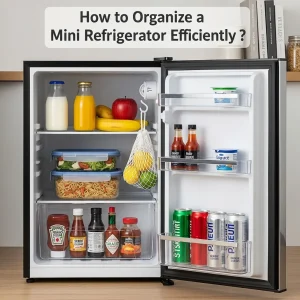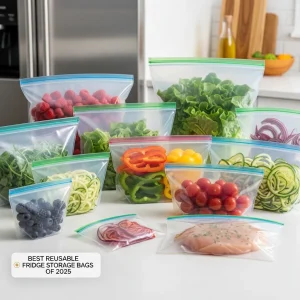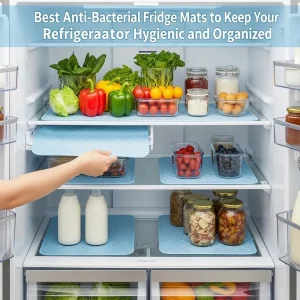My first mini fridge was a hand-me-down in my college dorm. I stuffed it with soda cans, leftover pizza boxes, and whatever else would fit. It wasn’t long before I encountered a warm beer, a mysterious puddle on the floor, and a smell I can only describe as “regret.” Through years of trial and error—in dorms, apartments, and now my home office—I’ve learned that a mini fridge is a fantastic appliance, but it demands a different strategy than its full-sized counterpart.
A mini fridge’s compact size and single cooling system mean that how you pack it directly affects its performance, your energy bill, and, most importantly, the safety and freshness of your food. After a decade of using them, I want to share the best practices I’ve gathered. This guide is all about making your small space work smarter, not harder.
Getting to Know Your Mini Fridge’s Personality
Before we start loading it up, it’s crucial to understand what makes a mini fridge different. Most have a single cooling coil, usually located in the freezer compartment or along the back wall. This means cooling is less even than in a large fridge. The back and bottom shelves will be the coldest spots, while the door shelves are the warmest, susceptible to temperature fluctuations every time you open it.
This isn’t a flaw; it’s just its design. Working with this knowledge, rather than against it, is the first step to success. Always check your user manual for specific details about your model’s cooling zones.
Your Step-by-Step Guide to Mini Fridge Organization
1. The Clean Slate: Start Fresh

The foundation of good mini fridge storage is cleanliness. I make it a habit to do a quick wipe-down of spills immediately and a full, deep clean every month. Unplug the unit, remove all shelves and drawers, and wash them with warm, soapy water. A paste of baking soda and water works wonders for stubborn stains and odors. Dry everything completely before plugging it back in. A clean fridge runs more efficiently and won’t pass old flavors to your new food.
2. Master the Temperature Zones

This is the most critical tip. Place items according to their need for cold:
- Bottom Shelf: This is the coldest part. Store your most perishable items here, like raw meat (if you must), dairy products (milk, yogurt, cheese), and eggs.
- Middle Shelves: These are great for prepared foods, leftovers, and ready-to-eat items.
- Top Shelf: This is the warmest area inside the main compartment. It’s perfect for drinks, butter, or any item that’s less prone to spoiling quickly.
- Door Shelves: Reserve this space for the least perishable goods: condiments, jams, juice, and water bottles. The constant temperature change makes it unsuitable for milk or eggs.
3. Embrace the Power of Containers

If I could give only one piece of advice, it would be this: use containers. They are a game-changer for space saving and organization.
- Square and Rectangular Containers: Round containers waste valuable space. Opt for square or rectangular food storage containers that can be stacked or lined up neatly.
- Clear Containers: Being able to see what’s inside at a glance prevents you from forgetting about food and helps you find what you need quickly without holding the door open.
- Small Bins and Baskets: Use small, clear bins to group similar items together. Have a bin for yogurt cups, one for cheese sticks, another for snack packs. This creates drawers within your fridge, making everything accessible and tidy.
4. Practice the “First In, First Out” Rule

This is a classic food safety principle. When you buy new groceries, move the older items to the front. This ensures you use the older food before it expires, drastically cutting down on food waste. I can’t tell you how much money this has saved me over the years.
5. Don’t Overcrowd It

It’s tempting to jam-pack every available inch, but this is a surefire way to kill your fridge’s efficiency. Cold air needs to circulate around food to keep it chilled. If the vents are blocked, the compressor has to work overtime, leading to warm spots, spoiled food, and higher energy consumption. Leave some space between items for air to move freely.
6. Cover and Seal Everything

Always store leftovers and food in airtight containers or covered with cling film. This prevents moisture loss, keeps food from drying out, and—most importantly—stops odors from mingling. Nobody wants their vanilla yogurt tasting like last night’s garlic pasta.
7. Be Smart About Your Freezer

Most mini fridge freezers are tiny and not very powerful. They are best suited for ice packs, ice cream bars, frozen vegetables, or pre-frozen items—not for freezing fresh food. Avoid overloading it, and never put hot items inside, as this can cause frost build-up and force the compressor to overwork. To defrost, always unplug the unit and let the ice melt naturally.
“The goal of an organized fridge isn’t perfection; it’s reducing the daily friction of mealtime.”
– Marie Kondo
Frequently Asked Questions for What Are the Best Storage Tips for Mini Fridges?
How often should I clean my mini fridge?
Give the interior a quick wipe for spills once a week. Plan for a full, deep clean where you unplug it and wash all the removable parts every one to two months. This prevents odors and maintains efficiency.
Why is there water pooling at the bottom of my mini fridge?
This is usually caused by one of two things. First, the drain hole at the back of the interior might be clogged with food debris. Use a pipe cleaner or cotton swab to clear it. Second, if the door isn’t sealing properly, warm, moist air can get in, condense, and drip down. Check the door gasket for cracks or food residue and ensure the fridge is level.
Can I put a mini fridge on its side to transport it?
You can, but you must let it stand upright for as long as it was on its side before plugging it in. This gives the refrigerant and oil time to settle back into the compressor. If you don’t, you risk seriously damaging the cooling system.
What is the ideal temperature for a mini fridge?
Aim for 37°F to 40°F for the refrigerator compartment and 0°F for the freezer. Use a standalone appliance thermometer to monitor it accurately, as the built-in dials are often unreliable.
How can I make my mini fridge more energy efficient?
Place it in a cool, well-ventilated spot away from direct sunlight and heat sources like ovens or radiators. Ensure there’s at least a couple of inches of space on all sides, especially the back, for heat to dissipate. Keep it full but not stuffed, as the contents help maintain a cold temperature.
“Efficiency is doing better than what is already being done.”- Peter Drucker
A Final Word of Encouragement
Organizing your mini fridge might seem like a small thing, but it has a big impact on your daily life. It saves you money by reducing food and energy waste. It keeps your food safe to eat. And it saves you time and stress by creating a calm, ordered little space where you can always find what you need.
You don’t need fancy products or a complete overhaul. Start with one tip—maybe just adding a clear bin for your drinks or moving your eggs to a colder spot. Small, consistent changes make all the difference. Your mini fridge is a powerful tool; now you have the knowledge to use it to its full potential.
“Small improvements are the key to big results. Start where you are. Use what you have. Do what you can.”- Arthur Ashe
I hope these tips help you build a better, smarter relationship with your mini fridge. Happy organizing







